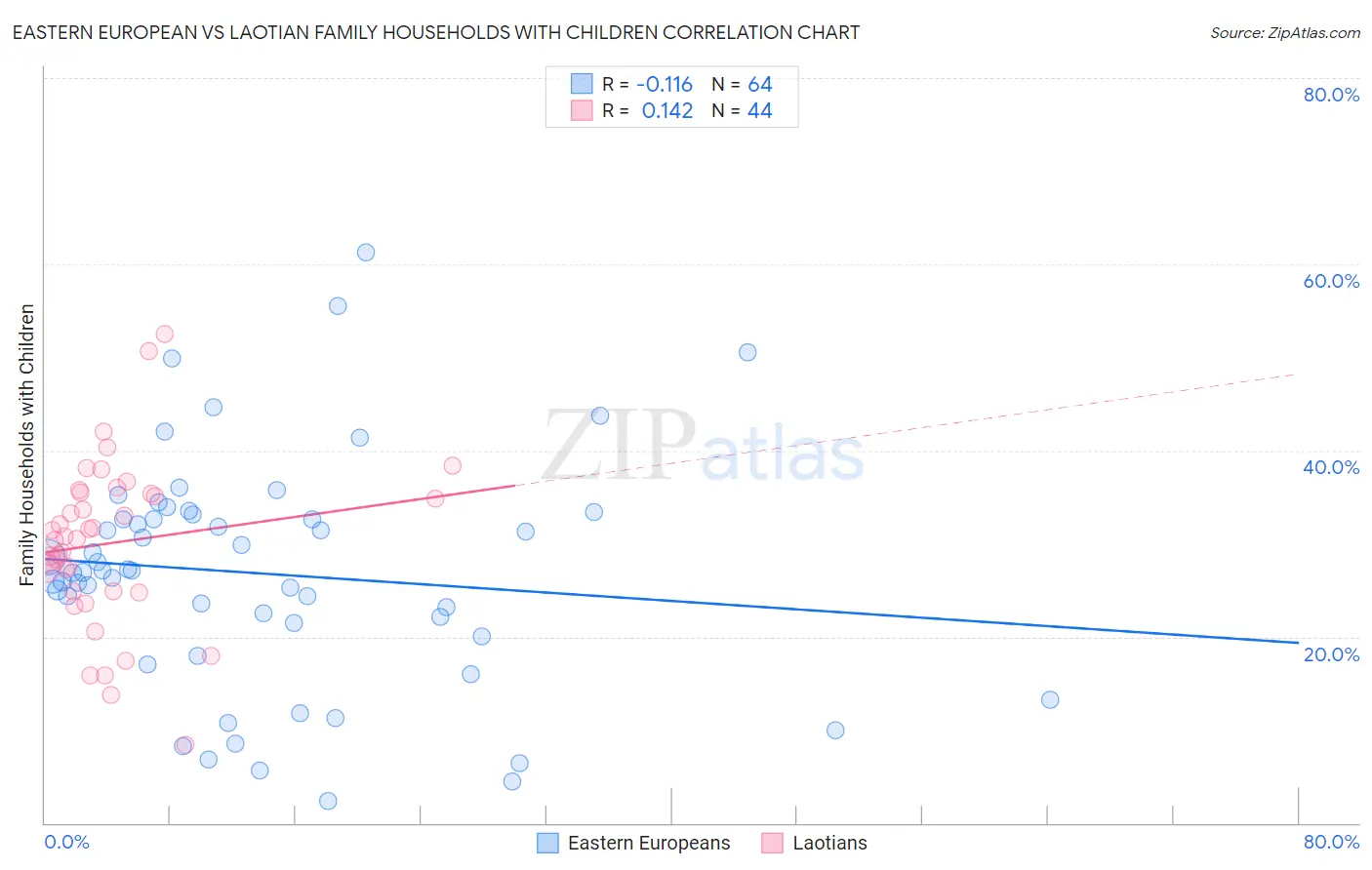Eastern European vs Laotian Family Households with Children
COMPARE
Eastern European
Laotian
Family Households with Children
Family Households with Children Comparison
Eastern Europeans
Laotians
26.7%
FAMILY HOUSEHOLDS WITH CHILDREN
0.6/ 100
METRIC RATING
274th/ 347
METRIC RANK
28.5%
FAMILY HOUSEHOLDS WITH CHILDREN
99.9/ 100
METRIC RATING
74th/ 347
METRIC RANK
Eastern European vs Laotian Family Households with Children Correlation Chart
The statistical analysis conducted on geographies consisting of 460,709,247 people shows a poor negative correlation between the proportion of Eastern Europeans and percentage of family households with children in the United States with a correlation coefficient (R) of -0.116 and weighted average of 26.7%. Similarly, the statistical analysis conducted on geographies consisting of 224,687,368 people shows a poor positive correlation between the proportion of Laotians and percentage of family households with children in the United States with a correlation coefficient (R) of 0.142 and weighted average of 28.5%, a difference of 6.8%.

Family Households with Children Correlation Summary
| Measurement | Eastern European | Laotian |
| Minimum | 2.3% | 8.4% |
| Maximum | 61.3% | 52.5% |
| Range | 59.0% | 44.2% |
| Mean | 26.8% | 30.1% |
| Median | 27.0% | 30.6% |
| Interquartile 25% (IQ1) | 20.7% | 24.9% |
| Interquartile 75% (IQ3) | 32.9% | 35.4% |
| Interquartile Range (IQR) | 12.1% | 10.5% |
| Standard Deviation (Sample) | 12.3% | 8.9% |
| Standard Deviation (Population) | 12.2% | 8.8% |
Similar Demographics by Family Households with Children
Demographics Similar to Eastern Europeans by Family Households with Children
In terms of family households with children, the demographic groups most similar to Eastern Europeans are Immigrants from Hungary (26.7%, a difference of 0.0%), Somali (26.7%, a difference of 0.040%), Immigrants from Northern Europe (26.7%, a difference of 0.090%), French (26.7%, a difference of 0.10%), and Immigrants from Zaire (26.7%, a difference of 0.11%).
| Demographics | Rating | Rank | Family Households with Children |
| Immigrants | Uzbekistan | 0.9 /100 | #267 | Tragic 26.7% |
| Immigrants | Belgium | 0.9 /100 | #268 | Tragic 26.7% |
| Immigrants | Denmark | 0.8 /100 | #269 | Tragic 26.7% |
| Immigrants | Zaire | 0.7 /100 | #270 | Tragic 26.7% |
| French | 0.7 /100 | #271 | Tragic 26.7% |
| Somalis | 0.7 /100 | #272 | Tragic 26.7% |
| Immigrants | Hungary | 0.6 /100 | #273 | Tragic 26.7% |
| Eastern Europeans | 0.6 /100 | #274 | Tragic 26.7% |
| Immigrants | Northern Europe | 0.5 /100 | #275 | Tragic 26.7% |
| Immigrants | Spain | 0.5 /100 | #276 | Tragic 26.6% |
| Celtics | 0.4 /100 | #277 | Tragic 26.6% |
| Immigrants | Europe | 0.4 /100 | #278 | Tragic 26.6% |
| Finns | 0.4 /100 | #279 | Tragic 26.6% |
| Senegalese | 0.4 /100 | #280 | Tragic 26.6% |
| Lithuanians | 0.3 /100 | #281 | Tragic 26.6% |
Demographics Similar to Laotians by Family Households with Children
In terms of family households with children, the demographic groups most similar to Laotians are Iraqi (28.5%, a difference of 0.010%), Immigrants from Indonesia (28.5%, a difference of 0.040%), Burmese (28.5%, a difference of 0.060%), Immigrants from Honduras (28.5%, a difference of 0.070%), and Immigrants from Korea (28.5%, a difference of 0.12%).
| Demographics | Rating | Rank | Family Households with Children |
| Ghanaians | 99.9 /100 | #67 | Exceptional 28.5% |
| Houma | 99.9 /100 | #68 | Exceptional 28.5% |
| Immigrants | Korea | 99.9 /100 | #69 | Exceptional 28.5% |
| Immigrants | Honduras | 99.9 /100 | #70 | Exceptional 28.5% |
| Burmese | 99.9 /100 | #71 | Exceptional 28.5% |
| Immigrants | Indonesia | 99.9 /100 | #72 | Exceptional 28.5% |
| Iraqis | 99.9 /100 | #73 | Exceptional 28.5% |
| Laotians | 99.9 /100 | #74 | Exceptional 28.5% |
| Immigrants | Jordan | 99.9 /100 | #75 | Exceptional 28.4% |
| Immigrants | Sri Lanka | 99.9 /100 | #76 | Exceptional 28.4% |
| Nigerians | 99.8 /100 | #77 | Exceptional 28.4% |
| Immigrants | Nepal | 99.8 /100 | #78 | Exceptional 28.4% |
| Immigrants | Iraq | 99.8 /100 | #79 | Exceptional 28.4% |
| Natives/Alaskans | 99.8 /100 | #80 | Exceptional 28.4% |
| South Americans | 99.8 /100 | #81 | Exceptional 28.4% |